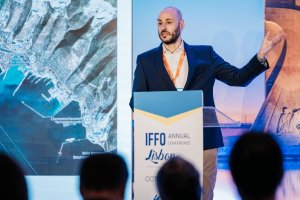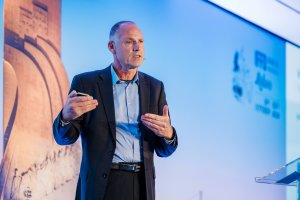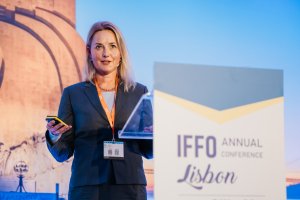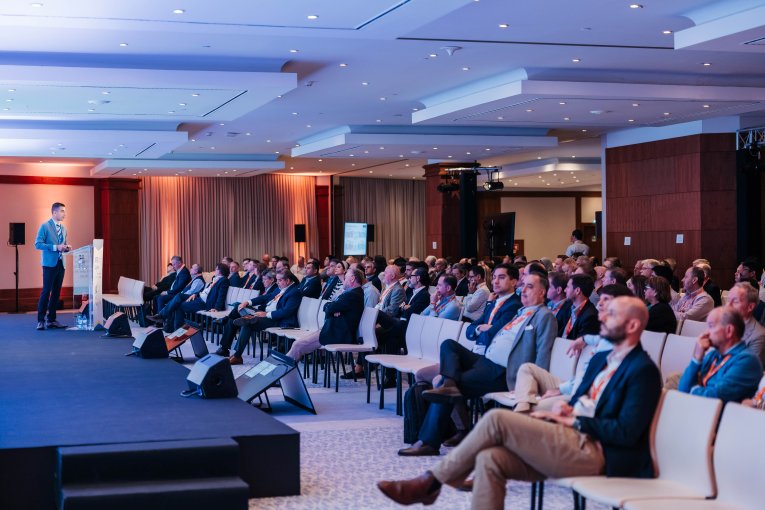The session started with an update on the Peruvian Anchovy Fishing Quota for the North-Centre: IFFO's Market Research Director, Dr Enrico Bachis, reported that Peruvian authorities had just announced the start of the second fishing season of anchovy and white anchovy in the North-Centre of the country for the year 2024 scheduled to be on 1st November 2024. The quota for this region has been fixed at 2.510 million tons.
The session focused on the market supply side, looking at ingredients and commodities beyond fishmeal and fish oil.
The Looming Agri Glut, and what could stop it
 Starting with agri commodities, Rabobank’s Head of Agri Commodities Market Research Carlos Mera discussed the current global restocking. Soybean and corn markets in the US, and soybean in Brazil Argentina have had good seasons so there is an overwhelming soybean meal surplus. Chinese importing of soybean drives the market, and following the challenges relating to swine fever, population growth and changes in farmers, China’s demand of soybean has slowed greatly, and this is likely to continue.
Starting with agri commodities, Rabobank’s Head of Agri Commodities Market Research Carlos Mera discussed the current global restocking. Soybean and corn markets in the US, and soybean in Brazil Argentina have had good seasons so there is an overwhelming soybean meal surplus. Chinese importing of soybean drives the market, and following the challenges relating to swine fever, population growth and changes in farmers, China’s demand of soybean has slowed greatly, and this is likely to continue.
With wheat, there is a global deficit, with a disappointing crop in the EU, UK, and Russia, and yields will likely be reduced in Ukraine. Wheat stocks in the US are doing well, with a fast-moving market and good crops, and exports are not competitive due to issues with the Panama Canal. Disruption caused by draught in the Panama Canal has increased export costs, these will likely decrease.
Mera provided an overview of the challenges facing cereal crops, including La Niña, which can lead to a drop in South America. La Niña brings heat and drought in the America’s, however rainfall projections look positive, followed by neutral conditions, so it will likely be a weak event. Another challenge is crop disruption, with the ongoing war in Ukraine: the country’s share in total exports is dropping: wheat has been dropping from 10% before the war to 7-8% now. Exports through the Black Sea are however continuing to flow, but the outlook is unpredictable. Pests and diseases are the final challenge, which cause harvest havoc and on a global level we will expect these to be higher, mostly driven by weather.
With vegetable oils, there is on-going growth apart from palm oil, where deforestation regulations slow the market. Soybean oil and palm oil are traded at the same level, with palm oil going up and soybean oil going down due to less demand and the US election, but prices will likely go up. Rapeseed oil prices have also increased but again they will likely go down. Deforestation regulations have caused anxiety in the industry due to the lack of clarity and clear guidelines in advance. Incoming EU regulations will ban any commodities grown on land converted after 2020, and there are multiple layers of detailed checks with the possibility of false positives.
Algal oil: friend or foe?
 Moving to Algal oil, Gertjan de Koning, the CEO of Veramaris, echoed the need of previous presentations to keep up with demand growth with all sources of EPA and DHA. Most of the demand comes from aquaculture, the rest being nutraceuticals and pet food. Addressing the carbon footprint challenges of land-based algal oil, Koning noted that although they cannot beat carbon footprint of well-managed fishery, they have worked hard to reduce it down by 27% in two years. The products are also being carefully tailored to specific diets and direct human consumption products. A huge share of the algal oil that is used is blended with fish oil. “Our market strategy is for algal oil to be used when fish oil is not available, it is an additional source of EPA and DHA”, Koning noted, adding that there is growing support from food retailers for algae inclusion to mitigate supply risk.
Moving to Algal oil, Gertjan de Koning, the CEO of Veramaris, echoed the need of previous presentations to keep up with demand growth with all sources of EPA and DHA. Most of the demand comes from aquaculture, the rest being nutraceuticals and pet food. Addressing the carbon footprint challenges of land-based algal oil, Koning noted that although they cannot beat carbon footprint of well-managed fishery, they have worked hard to reduce it down by 27% in two years. The products are also being carefully tailored to specific diets and direct human consumption products. A huge share of the algal oil that is used is blended with fish oil. “Our market strategy is for algal oil to be used when fish oil is not available, it is an additional source of EPA and DHA”, Koning noted, adding that there is growing support from food retailers for algae inclusion to mitigate supply risk.
Krill as a sustainable part of the solution
 Focusing on the krill markets, Aker BioMarine’s VP Product and Sustainability Ragnhild Dragøy insisted that krill is an important ingredient due to its low levels of CO2, dioxin, and low in the trophic food system, so high in energy retention, and certified. To ensure the total use of the krill biomass, different products are produced, ranging from side streams using the stick water and shell fraction to oil phospholipids and high fat meals. Including small amounts of krill meal can benefit palatability, digestion and overall health of the farmed fish. “This fishery is strictly managed by the Conservation of Antarctic Marine Living Resources (CCAMLR), and the quota where Aker fishes is set to only 1% of the total biomass” Dragøy noted. “Monitoring the biomass happens each year, with stocks remaining healthy with 60 million tonnes in 2000 and 63 million tonnes in 2019”.
Focusing on the krill markets, Aker BioMarine’s VP Product and Sustainability Ragnhild Dragøy insisted that krill is an important ingredient due to its low levels of CO2, dioxin, and low in the trophic food system, so high in energy retention, and certified. To ensure the total use of the krill biomass, different products are produced, ranging from side streams using the stick water and shell fraction to oil phospholipids and high fat meals. Including small amounts of krill meal can benefit palatability, digestion and overall health of the farmed fish. “This fishery is strictly managed by the Conservation of Antarctic Marine Living Resources (CCAMLR), and the quota where Aker fishes is set to only 1% of the total biomass” Dragøy noted. “Monitoring the biomass happens each year, with stocks remaining healthy with 60 million tonnes in 2000 and 63 million tonnes in 2019”.
Aker is investing in continuous improvement in fisheries and production, with no by-catch, eco harvesting, on-board processing for freshness, and reducing fuel spent per porduced meal. The industry is also setting up voluntary protection zones for penguins during breeding seasons. «Data and technology are key, with continious data streams from satellites and weather data providing accurate information for unmanned drone vessels to search for the krill, saving fuel and greatly increasing catches » she concluded.









